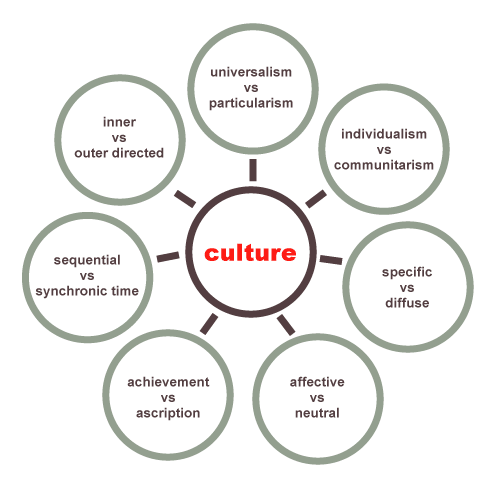Posts Tagged ‘Diversity’

According to Azhar (2003) organizational culture is the combination of important assumptions that are shared in common by each members of an organization and are often unstated. Organizational culture is basically made up by two major common assumptions: values and beliefs. Values are the assumptions that have been forwarded by the leaders of the organization and considered to be ideals that are desired by all the members of an organization. Beliefs on the other hand are the assumptions about the reality and created by experience. Robbins (1986) on the other hand, defines organizational culture as a uniform perception of an organization which has common characteristics. Organizational culture, according to the author is something descriptive and effectively it can distinguish one particular organization from another. It can also integrate individuals and groups of organization systems. Organizational culture is also defined by Rousseau (2000) as a set of commonly experienced stable characteristics of an organization which shows the distinctive features of an organization which differentiates it from others. Similar to the definitions of Azhar (2003) that has been stated above, Rousseau (2000) also define the organizational culture as set of norms and values that are shared by individuals and groups across the organization. Organizational values and beliefs refer to the common ideas about what the shared goals of an organization are, what types of behaviour should the members of an organization follow in order to achieve the common goals of an organization. These organizational values in turn form out the standard norms and guidelines for the organization that makes it distinct from others. Organizational culture is also defined by Schein (2004) as a pattern of shared assumptions that have been accepted by a group of individuals as they solve their problems. Because they have used these assumptions to solve their problems and…

Harrison (1972) presents a model of culture, known as Harrison’s Model of Culture that divides organisational cultures into the four categories: role, task, power, and person cultures. Organisations with role culture tend to be reliant on formal rules and regulations. In role culture organisations formal job descriptions of positions are more important than personal traits and characteristics of individuals taking these positions. In task culture organisations, on the other hand, the levels of skills and competencies to deal with tasks in hand are perceived to be the most important factor to exert influence. Task culture organisations tend to operate in project-based manner with specified deadlines for each project. Disadvantages of task culture organisations include conflicts of interests within teams and other relationship problems due to not clearly specified roles and responsibilities for team members. Power culture organisations tend to be highly autocratic, with a top executive exercising great power towards all organisational processes. The advantages of power culture in organisations can be listed as high speed of decision making and implementation of organisational changes. However, power culture is associated with a range of disadvantages as well that may include lack of constructive arguments and discussions, and lower level of employee motivation. In person culture organisations a specific individual serves as a source of influence for group members. This type of organisational culture is the least popular due to the fact that it lacks formal hierarchy, along with other disadvantages.

The theoretical framework of Cultural Dimensions introduced by Geert Hofstede as a result of assessing the values of more than 100,000 IBM workforce from 50 countries represent one of the most significant contributions to the development of cross-cultural studies. Hofstede differentiates cultures on the basis of following dimensions: individualism versus, collectivism, power distance, uncertainty avoidance, masculinity versus femininity, and long-term versus short-term orientation. Individualism versus Collectivism Individualism “describes the tendency of people to see themselves as individuals rather than as members of a group” (Velo, 2012, p. 26), whereas collectivism is associated with preference for group thinking and prioritising advantages of the group over individualistic advantages. In organisations where collectivistic culture prevails employees consider decision making to be the responsibility of superiors. Similarly, Andrews (2009) argues that employees in highly individualistic work cultures feel motivated to engage in decision making in an individual manner. Power Distance Power distance is an extent to which group members are willing to accept unequal distribution of power. In societies with high power distance unequal distribution of power is tolerated by group members to a great extent. Such societies managers are not generally approachable and the most popular form of communication is downward communication. In societies with low power distance, on the other hand, members of society are perceived to be more or less equal. Managers in low power distance organisations are viewed as peers by subordinates and there is usually two-way communication in such type of organisations. Uncertainty Avoidance Uncertainty avoidance dimension of culture refers to the degree of tolerance towards ambiguity and unexpected events and unstructured situations. Societies with high levels of uncertainty avoidance prefer to operate within highly structured environment and generally they have negative approach towards uncertainties. Bhattacharyya (2010) recommends the development of clear procedures and directives when…

Trompenaars and Hampden-Turner Cultural Dimensions consists of universalism versus particularism, individualism versus collectivism, achievement versus ascription, neutral versus affective, specific versus diffuse, internal versus external, and time orientation. Universalism versus particularism relates to the extent of importance of formal rules and procedures over circumstances and relationships. Universalistic cultures rely on formal rules and regulations to govern various aspects of life, whereas members of particularistic cultures tend act according to circumstances. Bhattacharyya (2010) links this specific cultural dimension to the levels of paperwork and bureaucracy in organisations. According to Bhattacharyya (2010), the levels of organisational bureaucracy are usually greater in organisations with universalistic cultures compared to particularistic organisations. Individualism versus collectivism is similar to relevant cultural dimension proposed by Hofstede as discussed above. In individualistic cultures interests of individuals usually prevail over the interest of the group, whereas in collectivistic organisations the whole teams, rather than individuals are credited with organisational successes, as well as, failures. Achievement versus ascription marks the level of tolerance of society towards the pattern of distribution of power and status amongst members of society. This cultural dimension is quite similar to power distance cultural dimension presented by Geert Hofstede. In societies and organisations with achievement-oriented cultures power, status and other befits are provided for individuals that are high achievers. In ascription-oriented organisations, on the other hand, power and management positions are given on the basis of family backgrounds, age, gender and others. Moran et al. (2011), Maude (2011) and a range of other authors present convincing arguments about the advantages of achievement-oriented organisational cultures over ascription-oriented organisations in terms of increasing the level of effectiveness in achieving organisational objectives. Specifically, employees in achievement-oriented organisations are found to be better motivated to contribute to the achievement of organisational objectives compared to employees in ascription-oriented organisations. Neutral versus affective…

It has been argued by Saad (2012) that there are no vast differences between highly developed and developing countries in terms of criticism associated with the nature of representation of women in media advertisings. However, the levels of frequency and intensity associated with these criticisms differ across counties depending on a range of factors such as religion, values, cultural specifications etc. Generally, criticism associated with the nature of representation of women in media advertisements can be divided into the following three categories (Cortese, 2007, Abel et al., 2010, Biermann, 2011): Women being represented as less capable and less intelligent than men Women being represented as servants to men Women being represented as objects for sexual satisfaction The role of religion on the nature of representation of women in media advertisements has been stressed by Ross and Byerly (2008). Specifically, it has been claimed by Ross and Byerly (2008) that in some religions such as Islam and Judaism indication to female intimate issues in public manner is strictly forbidden, and this would have direct implications on the nature of representation of women in media advertisements in relevant societies. Frith and Mueller (2010) mention a large-scale gender-role stereotyping study conducted by Furnham and Mak (1999) that involved data collection from America, Australia, Denmark, France, UK, Hong Kong, Indonesia, Italy, Kenya, Mexico and Portugal. This specific study has found that across a wide range of cultural settings in advertisements women are most often pictures within home settings, whereas men are pictured in advertisements in diverse settings. Moreover, findings of the same study indicate that the images of women are mainly used to advertise home utilities and products, while images of men are used to advertise products and services that are distant from home. References Biermann, G. (2011) “Stereotypes Galore! Women’s Emancipation as…
